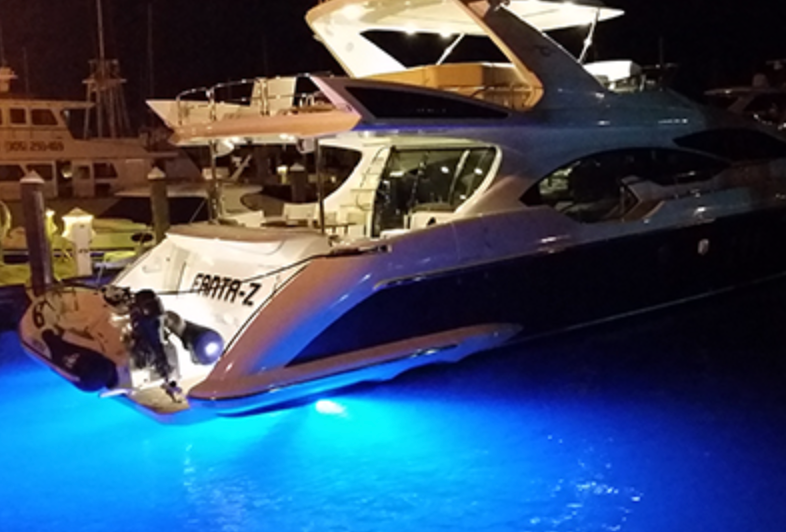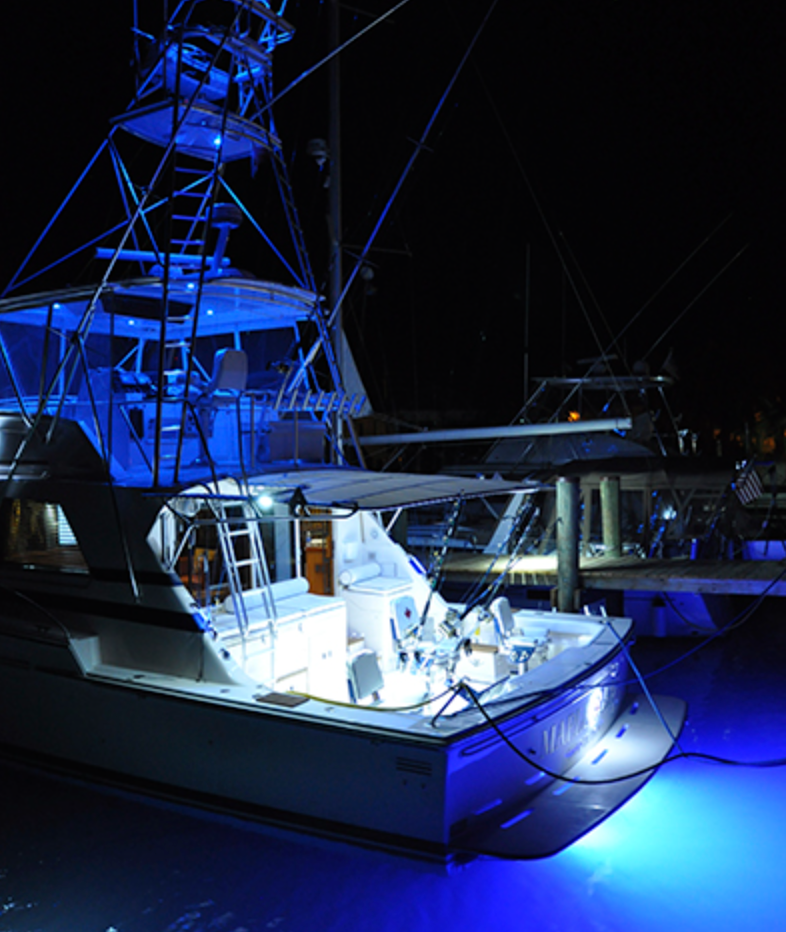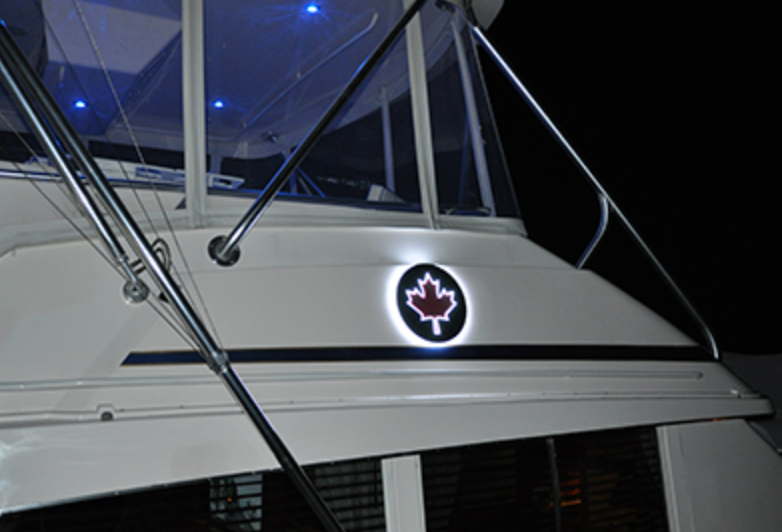Light Up Your Cruising Nights

Among new luxury cruisers sold in Florida, the number equipped with underwater lighting is likely in the 90th percentile. Walk the docks at night and what used to be dark and maybe even a bit dangerous, is now a remarkable display of light that transforms those dark harbor waters into something like a luxury hotel swimming pool.
Underwater lights are gaining in popularity up and down both coasts of North America, throughout Europe and across Asia. And there’s more to it than just looking cool at the marina.
What Is The Benefit?
First, underwater lighting is eye-catching and can be pretty dramatic, but there are a whole range of benefits that you might not have considered. Swimming in light at night is just one of them.
On the docks at night in a marina or yacht club, the added lighting offers a significant safety benefit. We talked to boaters who found other positives. One captain was boating on a crowded waterway late at night last summer. He was in a passage wide enough to allow unrestricted speeds, but it was still narrow, with lots of lights on the nearby shore reflecting on the water and several boats moving at various speeds.

It became difficult to pick out the running lights from the other reflected light and his big concern was being rear-ended by another, faster vessel. We have been advised that running with underwater lighting on is not illegal or restricted and it could have made his boat more visible and safer.
Many Advantages
White lights attract fish and some anglers use them in Florida, but Canadian boaters should be aware that the practice is illegal north of the border. Swimming with underwater lights illuminated is safer because the swimmers can be seen more easily, they can see the boarding ladder and they are less likely to slip or fall. Additionally, tow sports boats look good with their lighting on and those boats are designed for swimming and easy access to the water.
At least for now, there are underwater lights on more powerboats than sailboats. Any captain who has ever run aground, snagged an old piece of line in the prop or had a rudder issue can understand that a well-placed underwater light can make the task of diving to troubleshoot far easier. For people who use their boat as a second home, underwater lighting can be a
Color and Power
When choosing underwater lighting, color is key and so is output. Many LED units are available in blue, white, green and red and that’s just the beginning.
We learned that red doesn’t penetrate water well but green does. Then again, with green and white you will see pigmentation in the water. Blue doesn’t show particles in water and for many reasons, blue is probably 90% of all sales. Elaborate systems are available that can change colors, and some can “strobe” in time to your music.

Entry Level and Boat Sizes
LED lighting draws relatively little current compared to conventional incandescent lighting or halogen bulbs. For smaller power boats, the entry level starts with a simple single LED fixture that goes into the drain plug hole (replacing the drain plug). You just need a bit of fused wiring and power to at light up the stern enough to see the lower unit or sterndrive, some of the surrounding water and what is in it.
Going up in size and power, choose models that are surface-mounted and just require a small hole for wires, or lights that require a slightly larger diameter hole for a shaft that fastens all the way through the thickness of your transom, but with a small diameter hole. The shaft on some models is as small as ½” (1.27 cm) even though the light fixture seems to be perhaps 3” (7.62 cm) or more in diameter. Bed the fixture in sealant and tighten it before connecting the wires inside the boat.
As the light output levels go up, the fixture sizes increase and the hole for the shaft may as well. A significant part of the LEDs themselves and the electronic components needed to run them are installed in the shaft, not outside the boat. Obviously, you don’t want a fixture that protrudes and could be damaged if a piece of debris sweeps past for example.

Mounting Location Options
Lighting that’s designed for hullsides needs to be flush and smooth for the water flow, watertight and able to withstand higher operating temperatures. The same goes for transom mounted lights if you plan to run with them on. At rest, the water cools the fixtures but when moving, they may no longer be submerged and the heat can shorten the life of LED lights.
So can overpowering LED lights. Experts recommend driving them to about 75% of capacity. A user can vary how much light is generated. There are small lights like 6-watt models but 18-watt models are more popular and power goes up to 60-watt models. A single light can still offer useful illumination but two or three across the transom gives the best illumination spread.
When it comes to cost, one supplier pointed out that the consumer does not see technology but you basically get what you pay for — less expensive imported lights may leave you with no recourse. Go with the better known brands/
Especially on smaller boats, a capable DIYer can do the installation, but for larger vessels, we recommend you buy from a reputable yard that will install the system correctly. Wiring is fairly simple but you need a good seal and a dealer who offers warranty coverage. Make this the summer you light up your cruising nights. There’s plenty of time to have them installed for launch day.